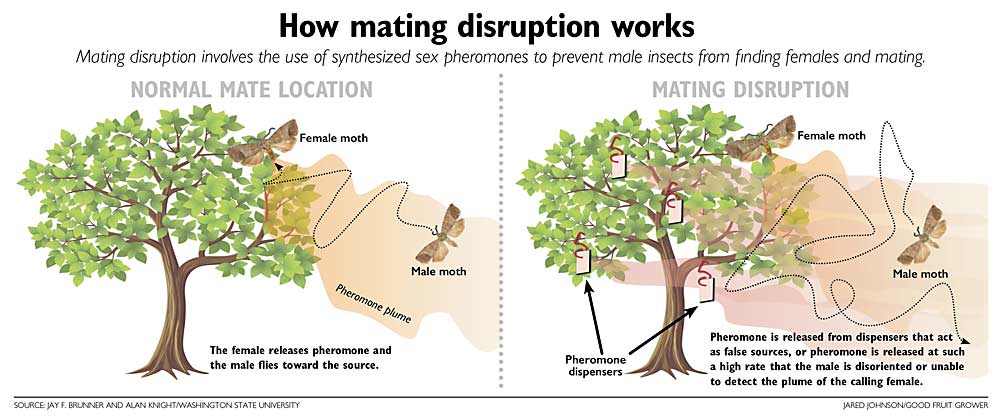WTFRC 50th Anniversary
As the Washington Tree Fruit Research Commission celebrates its 50th anniversary, we’re taking an opportunity to reflect on some of the significant research impacts that grower assessments have generated in three different areas: crop load management, integrated pest management and postharvest. Here, we talk about the significant gains made in codling moth control through mating disruption research.
Codling moth originated in Central Asia but has been a significant pest of North American apples and pears for more than 200 years. In the 1940s, synthetic organic insecticides became available to help control codling moth in commercial orchards. However, as resistance to those traditional codling moth products grew, so too did the need for new control methods.
Early research showed the value of pheromones for mating disruption against pests in a number of crops. In 1991, the first commercial pheromone-based technology was registered for codling moth mating disruption (CMMD).

Recognizing the increased regulatory pressure on organophosphate insecticides, particularly azinphosmethyl (the most commonly used control tool at that time) and its reduced efficacy against codling moth, the Washington Tree Fruit Research Commission (WTFRC) began providing support in the 1990s to develop effective mating disruption systems for codling moth control.
From 1991 through today, in support of university, USDA-ARS and industry personnel, the WTFRC has provided over $2.1 million to develop new methods of pheromone delivery for control of codling moth and to extend the outcome of that work to the apple and pear industry.
“WTFRC was critical in funding and driving research, creating industry optimism and confidence in this technology, and getting grower buy-in,” said Don Thomson, head of Pacific BioControl Corp. of Vancouver, Washington, the first company to successfully market a CMMD tool.
The early “WTFRC-funded efficacy trials helped to elevate mating disruption into the public limelight and laid out parameters for implementing the technology.” At that time, “Pacific Biocontrol was a small company with a small research budget,” said Thomson. “Mating disruption would not have been implemented as quickly as it was, if not for WTFRC funding.”
In 1995 the USDA redirected funding to support an areawide project focused on CMMD in California, Oregon and Washington. Three areawide codling moth sites were located in Washington state. The codling moth areawide management project (CAMP) was highly successful at all locations. Between 1995 and 2000 it was estimated that apple acres treated with CMMD increased from 10 percent to nearly 50 percent.
Grower adoption of CMMD has steadily increased since 2000 and, based on a recent grower survey, it is estimated that 90 percent of apple acres in Washington were treated in 2015.

Illustration: Jared Johnson/Good Fruit Grower
According to an impact assessment provided by retired Washington State University entomologist Jay Brunner, placing an economic value on the use of a pest control technology is a challenge.
Pesticide use survey data from the National Agricultural Statistics Service (NASS) showed that an average of 3.2 insecticides were applied per acre between 1991 and 1997. However, between 1999 and 2011, when the adoption of CMMD was increasing, the average number of insecticides applied for control of codling moth was down to 2.0 per acre.

According to Brunner’s assessment, the value of eliminating a single codling moth insecticide application to 90 percent of bearing acres is estimated at $12 million annually in the apple industry alone.
In addition, given the importance of certified organic production to the Washington fruit industry, it is important to note that the relatively large-scale move to organic apple production seen in recent years would not have been possible without effective mating disruption technology.
Without CMMD, even utilizing other certified organic control tools, codling moth damage could easily reach levels that would force a move away from organic certification.
In the 2016 crop year, almost 11 million cartons of organic apples were sold, at an average premium of $19.87 over conventionally produced apples, according to the Washington State Tree Fruit Association’s Annual Crop Summary. It is estimated that the use of CMMD technology in organic apple orchards translated into almost $215 million in higher returns to our industry that crop year.
While control of codling moth will remain a significant challenge and no single tool will likely last forever, the economic impact of WTFRC funding of CMMD demonstrates the ongoing value of committing grower funds to research. •
—by Mike Willett and Rob Curtiss
Mike Willett is manager and Rob Curtiss is special projects coordinator for the Washington Tree Fruit Research Commission, which is celebrating its 50th anniversary this year.






Leave A Comment